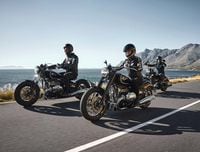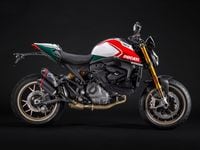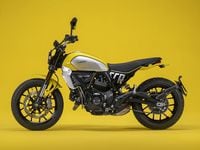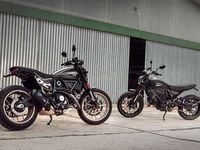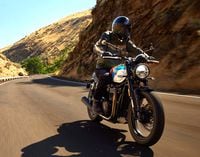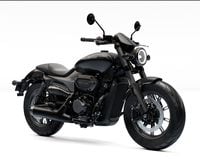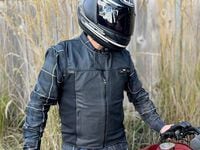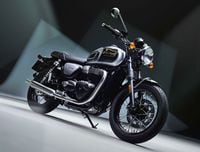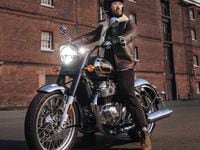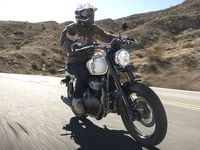U.S. 6 East, Provincetown, MA, 3205 Miles." That sign, on the outskirts of Bishop, California, reads like an invitation. And with Harley's new Street Glide waiting to go for a ride, I decided to accept it. Being a Westerner, I needed a map to learn that Provincetown was at the tip of Cape Cod.
The Street Glide brings Harley's touring motorcycles into the third millennium. Though basic elements are plainly culled from the Electra Glide parts bin, the FLHX Street Glide cleans up its profile and details, creating a sleeker, more purposeful Harley bagger. It wears no fender bumpers, tip lights or rails. There are no spotlights. The batwing fairing sprouts just the briefest windshield and mounts black mirrors behind the wings instead of stalks. The saddle has a smoother, lower profile, especially the passenger section. Hard nylon saddlebags without the traditional full-height chrome roll bars ahead of them have color-matched latches (which a remarkable number of people commented on favorably). Extensions carry the rear fender farther down and give a more integrated appearance. Additional details-Streamliner floorboards and controls with matching passenger pegs, a stretched console atop the tank, slash-down muffler tips, a license and taillight lower on the fender-further tidy up its looks. The largest functional difference is the low-profile rear suspension, offering a meager 2.0 inches of travel instead of the Electra Glide Standard's more adequate 3.0.
All told, the FLHX leaves behind about 13 pounds of stuff that the similar Electra Glide Standard includes, although the Street Glide gets the Harman/Kardon 40-watt AM/FM audio system standard.
Harley offers optional modules you can plug into the audio system, including a GPS with a monochrome non-map display ($1100), a high-output amplifier ($446), a rider-passenger intercom ($106), CB radio ($300) and a Bluetooth cellphone interface ($496). That last item is probably a bad idea considering all the evidence that talking on a phone, even handsfree, is a serious distraction. I still wanted to try the XM satellite radio ($496), however.
I wondered if the seat would be as comfortable at the end of the day, much less after 7000 miles, as it had been after a few hours. I was also dismayed to see that my sample had the optional Chromed Aluminum Profile laced wheels with tube-type tires instead of the standard black slotted cast alloy wheels and tubeless tires. Harley's fleet-center rep opined that I would likely want a taller windshield. As it turned out, the 4.5-inch-tall smoked windshield was one of my favorite features. It thoroughly deflected wind from my chest and shoulders, but did not obstruct my view of the road significantly.
My ride home from the fleet dealer wasn't long enough to allay any concerns. That night I checked over and loaded the bike up for two weeks on the road, wishing for a few more anchor points for bungee cords around the passenger seat. Shortly before noon, I shut off my computer and headed north for Bishop. I used a GPS to calibrate the speedometer, which turned out to be barely more than one mph optimistic at 70. The odometer/tripmeter proved to be equally accurate.
In the desert heat, I was grateful that the Street Glide has no lowers. I experimented with different leg positions on the floorboards and passenger pegs to find how to deflect the most and least air up behind the fairing. The fairing effectively turns away wind between your knees and the top of the helmet, but with my legs arranged to catch the air, I was still able to get significant cooling flow.
I got to Bishop a bit after 4:00 pm, having confirmed that the Street Glide had enough range with the 5.0-gallon tank topped with premium to make the 170-mile run from my first stop on U.S. 6 at Tonopah, Nevada, to Ely on the east side of Nevada. (During the trip I'd learn the tank's capacity was more like 5.4 gallons.)
Though simple and comparatively small (this was a 2006 1450cc model), the twin-cam engine has plenty of power for climbing the 7000-foot passes I encountered that day, easily passing slower traffic. It's stronger than some bigger V-twins, and the simple air-cooled two-valve twin gets impressive fuel mileage. Heavily loaded and going fast, the FLHX delivered an average mileage of almost 39 mpg, hitting 46 on the rare occasions when I slowed to a steady 55-60 mph. Premium fuel negates any savings, but good mpg and respectable fuel capacity give reassuring range when gas stations are scarce. Holding the bike upright during fueling ensures that maximum fuel gets into the center-filler tank.
The gearbox and clutch are about average for big twins in terms of shift ease and certainty and better for clutch effort and engagement. The six-speed (see sidebar) is an improvement, though.
It always takes a few miles to get to trust a bike, but aside from the Street Glide's unsophisticated chassis performance, I had no complaints. The saddle and my glutes formed a happy alliance, and even after almost 1000 miles in 18 hours, I suffered no backside distress. The seat offered a margin of wiggle, and the variety of foot positions on the floorboards, passenger pegs and engine guards offer options for adjusting posture and pressure points. If I were bit taller than my 5 feet 10 inches or longer than my 32-inch inseam, I might have wished for more legroom, but as I am, the Street Glide fits me perfectly. The handlebar has a near-perfect bend for me as well.
Passengers don't have deluxe seating. You'd want to slip on a cushier saddle for a long ride two-up. Back-seaters also don't have a lot of space, particularly if they're tall. Harley's relatively short 63.5-inch wheelbase makes steering more responsive and improves cornering clearance slightly. The tradeoff is less space than that on a longer bike.
Despite a solid shudder right off idle, vibration wasn't a comfort issue. Rubber mounts thoroughly squelch the shakes before they reach the rider as soon as the revs rise slightly.
Riding into the mountains east of Delta, Colorado, to visit friends on my second night, I was pleased with how effectively the high beam illuminated the road and shoulders. And the instrumentation-speedo, tachometer and fuel, oil-pressure and air-temperature gauges-is well lighted and readable at night. My wish list includes a second taillight/brake-light bulb for backup if one fails. Although I think Harley's two-button turn-signal activation compromises your right hand's more important duties, I'm impressed by how well the self-cancellation system works.
Winding over 8735-foot-high McClure's Pass, nice twisty roads highlighted flaws in the Street Glide's chassis performance. The bike shimmies during high-speed (65 mph and above) cornering with changes in pressure-a bump in the road, steering inputs, a sharp change in throttle setting or a shift in rider position. The faster you go, the more forcefully it oscillates. I deliberately wiggled the handlebar to set it off at speeds up to 100 mph in a straight line, and though it never got out of hand, it took longer to stabilize than most other brands' cruisers in the same situation. I also knew just to hold a steady speed, throttle setting and cornering arc and let it settle down. Additional bumps will make it continue or amplify it, though. In my opinion, the biggest danger this creates is to startle the rider into straightening up, which could cause him to run out of his lane, especially in an off-camber corner. There are some aftermarket kits available to correct this problem, which happens in part because the swingarm attaches to the rubber-mounted engine.
I was worried the FLHX was too low to lean over adequately in corners, but although it doesn't offer as much cornering clearance as an Electra Glide, it leans farther than baggers from most other brands. The sidestand drags first, but has plenty of give. You can keep leaning until the floorboard touches. The floorboard is also the first thing down on the right.
Steering is impressively light and predictable, allowing the Street Glide to steer more responsively than most cruisers-even non-tourers. Low-speed handling is exceptionally good, and the FLHX makes U-turns on narrow roads or threads through tight spots with ease. This is one of the nicest things about the bike.
Topping 11,990-foot Loveland Pass, the temperature gauge warned that the melted snow on the road was near freezing, making me slow down and straighten up. At that altitude, I was grateful for electronic fuel injection, which better adjusts for thin air than a carburetor (which was standard in 2006, but no longer available for 2007). Though power dropped noticeably, it was still smooth and responsive and not as weakened as I'd expected. Passing traffic was still no problem. The locals may remind you that the thin air effectively decreases compression ratio, permitting fuel with lower octane.
The canyons east of Denver were the only place where the XM signal was sketchy for any period of time. It was also blocked under gas-station canopies, in tunnels, etc. It does live up to the promise of listening to the same stations from coast to coast. Above 55-60 mph, wind noise overwhelmed the audio. I could tell what song I was listening to, but I couldn't make out enough words to make news or weather stations worthwhile on the interstates. I'd add the high-output amplifier, and a taller windshield might also help.
Route 6 through the plains of eastern Colorado and Nebraska is unremarkable, and I wished for the optional $340 cruise control as I tried to maintain an even speed. It was hilly enough that the thumbwheel-operated throttle lock wouldn't do it. Throttle pressure is light and comfortable and didn't tire my hand or wrist. Smaller grip diameters would be nice, even for my size-L paws.
When I drove into a heavy rain approaching Iowa, I was thankful for the cut-down windshield, which didn't cloud my line of vision with two layers of water droplets. The rain seemed to hit from the armpits up and somewhere below the knees, but I stayed mostly dry.
Rougher roads in Illinois highlighted the Street Glide's limited rear suspension travel. The inch of rear-wheel travel it gives away (compared with the Electra Glide Standard) lowers the seat by 3.4 inches when it's unladen, but only an inch when you're sitting on it. However, the Street Glide doesn't have as much travel to absorb bumps and potholes as the other Harley Touring models. Overall, the ride at the rear was better than I expected for two inches of travel, but I still rode around bumps.
I learned to leave my helmet on with the faceshield down when unpacking the bike in the dark, as the black antenna is invisible and just at the right height to poke you in the eye. If I owned the bike, I'd put some brightly colored flag or ball on the antenna's end so I and others wouldn't be inflicted with antenna-eye syndrome. After unpacking, I'd bend the antenna under the grab strap to make sure no passersby were poked.
Just into Pennsylvania, I met another Harley rider planning to ride Route 66. His "waterproof" gloves were soaked, making me appreciate how effectively the Street Glide's fairing had been keeping rain off my gloves. I also liked the unique mirrors mounted on the backs of the wings. Besides being cleaner than long-stemmed mirrors, they provide a good view. I didn't have to worry about loosening them at their mounts when I readjusted them, and they seem to be out of harm's way if you tipped over. The only disadvantage I can see is that handlebar changes could block them.
By now I had enough wet-road time to develop a good idea of the Dunlop tires' considerable capabilities in the rain. I could comfortably lean far enough to drag in the longer corners, and the road offered some nice turns to do so. There was little traffic, and my only real concern was deer.
I wanted to get to Danbury, Connecticut, that night to have breakfast the next morning with our own Mark Zimmerman. I considered a side trip to the Grand Canyon of the East, but by the time I was rolling, the black clouds ahead discouraged that. It was obviously pretty country, but the heavy rain kept me from seeing much. On the local news in Danbury the big story was record flooding.
The flooding story was being played even bigger the next morning. I decided to leave my gear (except my tools and cameras) at the hotel, ride out to Cape Cod, and return to Danbury that night. Of course, Mark and I got to yakking over breakfast, and I finally got going around noon, with the rain still pouring. Some of U.S. 6 was flooded, bringing traffic to a crawl. I finally went back to the interstate.
Eventually, U.S. 6 ended-not with a bang, but with road construction. I couldn't actually tell where it concluded, but by now I was getting damp. In a completely deserted beach parking lot, I walked to the water, dipped a foot in, used a restroom and started back west. On the way down the Cape, I passed the counterpart of the sign in Bishop, advising me that it was 3205 miles ahead, except the 2 was missing. Somehow, "3 05 Miles" didn't seem as intriguing.
I gave the bike a check the next morning after having traveled about 3800 miles. It looked pretty grimy from the continuing rain, but the only thing that had loosened was the nut that held the lock on the gas-cap cover. I'd noticed that in Utah and removed it so I wouldn't have to unlock it at every gas stop. (I'd buy the push-button latch that replaces the key lock.) The only attention the FLHX needed was a quart of oil, the only oil it required for the trip.
I headed for Columbus, Ohio, that night. Despite continuing rain, the ride was pleasant, and I made good time, with one incident. About an hour after dark, a driver lost control and spun ahead of me in a construction zone. I was riding with both brake controls covered and was able to get on the brakes quickly and forcefully. I'd had several days to practice wet stops on the Street Glide, and it paid off. I could slow quite hard and straight with just a slight loss of traction at the rear. The Street Glide's triple disc brakes are easy to control, with the rear a bit more sensitive than I prefer. You need a biggish paw to wrap all four fingers around the front lever easily, but it is controllable and predictable. I wish Harley would use adjustable levers so smaller hands could easily get proper purchase. I was impressed again with the Dunlops' wet traction.
The rain lightened the next morning, and a few miles down the road, some blue patches appeared toward the western horizon. Soon I was on dry pavement and wondering if I could actually put my rain gear away. Approaching the Indiana line, I stopped for a Yamaha FJR1300 rider on the shoulder with what sounded like a bad electrical connection. I suspected a loose battery lead. The problem was that neither of us knew where the battery was. (Keep your owner's manual on your bike.) We dug around for a while, and he finally called his shop. Once we learned the battery was in the fairing's right side, the bolt was tightened, and we were both on our way again.
Harley's saddlebag lid-latching design doesn't require much vertical space to open, so digging out tools at the roadside isn't a challenge. When properly fastened, they are completely waterproof (believe me!), and you can lever down on the contents if you overpack. Be sure the ears on the backs of the lids are aligned, though, or the lids can come loose and flop open. I misaligned them a couple of times and had to stop. You can lock them with the ignition key.
As I headed west through Colorado, the audio system mysteriously quit making noise. I never figured out if it had failed or if I had done something that silenced it. There was no manual, so I had no guidance to resurrect it. The display worked, however, so I still had a clock. Interstates 70 and 15 through Utah are some of the most scenic superslab in the country (especially where 70 crosses the Capitol Reef), so I didn't really miss the music. But I did want it the next day when I hit the hot, barren desert on I-15 north of Vegas. I got some relief from a nice little thunderstorm just after crossing into California.
After almost 8000 miles in 13 days, the Street Glide still ran flawlessly, and there was plenty of tread on the Dunlops. I tightened the seat screw once. A windshield screw and the tripmeter-reset button's nut had departed. The audio system's silence was the only real problem.
Those 8000 miles made me a fan. The Street Glide has displaced the Kawasaki Nomad as my favorite bagger. However, which one I would buy would depend on how deep my pockets felt. At about $18,500 plus tax and options, the FLHX is about $5500 more than the Nomad. I prefer the Kawasaki's suspension and saddlebags. The audio system makes up for some of the Street Glide's cost, and so does the fact that the FLHX is more responsive, powerful (even with the 1450cc engine) and considerably more comfortable for me. Still, $5500 is a sizeable stack of cash.
Of course, if the Street Glide's 21st-century style turns your head, it could be hard to convince yourself that you really should head for the opposite coast on anything
Riding The 2007 Street GlideDo 134cc and one more gearbox ratio really make a difference?If you asked what changes I'd like to make to the 2006 Street Glide I rode across the country and back, more power wouldn't be in the top five, maybe not even in the top 10. However, I would ask for the six-speed drivetrain. As it turns out, all 2007 Harley big twins now offer both of the above in the form of the 1584cc Twin Cam 96 engine and six-speed Cruise Drive transmission.
Since I rode the 2006 FLHX immediately prior to 2007 Harley's press ride, the new FLHX was the bike I sought out first. The only significant change is the new drivetrain, so I would be able to focus on it.
For me, the most valuable change is the lower first gear. With the lighter clutch introduced in '06, it makes every take-off much smoother. It also meshes wonderfully with the Street Glide's excellent low-speed handling to make low-speed power as manageable as handling. Pulling away from a stop with the front end turned to the steering lock is easy; you can put your feet on the floorboards immediately and feel completely confident. Stop-and-go traffic isn't nearly as irksome. Closer ratio spacing makes it easier to shift smoothly, and shifting is quieter and smoother. I had no trouble finding neutral, but the light on the dash sometimes said I was in neutral when I wasn't.
Sixth gear is higher than the old fifth, dropping rpm slightly on the highway. The stronger engine easily overcomes the taller gearing and seems to pull harder in top than before. The motor and ratio changes combine to focus the bulk of the extra power where you want it most-for passes on the highway and at moderate rpm around town. Of course, if you want a stronger lunge, a downshift provides a milder change in rpm than with the five-speed. With fewer rpm at any given speed in top gear, fuel mileage should improve slightly.
If you're used to a carb, you'll probably be impressed by the fuel injection's crisper throttle response, now standard on all Harleys. You'll certainly like the instant starting. However, you still need to buy premium fuel for Big Twins.
With less noise from the gearbox, Harley's engineers could let more come from the exhaust system. The exhaust note is noticeably sharper and more robust.
Harley hopes the TC96 engine and Cruise Drive will motivate existing Harley owners to trade up. The new powertrain offers solid power and functional advantages with no drawbacks, so that may happen. Certainly, riders of '07 models are going to ride with a little extra swagger.










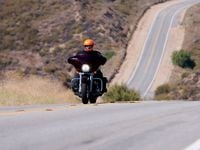
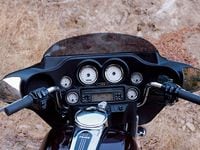
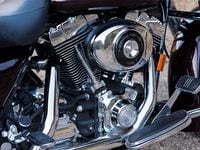
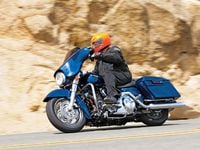
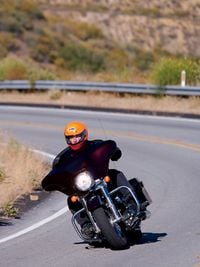
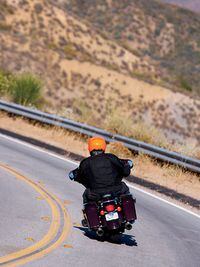
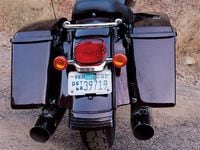
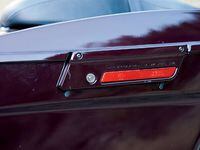
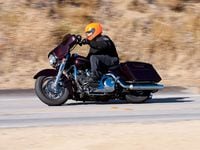
/cloudfront-us-east-1.images.arcpublishing.com/octane/H6Z2IC7WYRBXZNQS4MI3SZ5KPQ.jpg)
/cloudfront-us-east-1.images.arcpublishing.com/octane/IWO5T5PBT5E4HFQ5GK47H5YXR4.jpg)
/cloudfront-us-east-1.images.arcpublishing.com/octane/OQVCJOABCFC5NBEF2KIGRCV3XA.jpg)
/cloudfront-us-east-1.images.arcpublishing.com/octane/F3O2DGLA4ZBDJGNVV6T2IUTWK4.jpg)
/cloudfront-us-east-1.images.arcpublishing.com/octane/ZXYQE3MHLFDSPKNGWL7ER5WJ4U.jpg)
/cloudfront-us-east-1.images.arcpublishing.com/octane/RDF24VM7WVCOBPIR3V3R4KS63U.jpg)
/cloudfront-us-east-1.images.arcpublishing.com/octane/W7RSIBFISNHJLIJESSWTEBTZRQ.jpg)
/cloudfront-us-east-1.images.arcpublishing.com/octane/AERA26ENRNBW3K324YWCPEXYKM.jpg)
/cloudfront-us-east-1.images.arcpublishing.com/octane/YWX3YX7QBBHFXFDMEEEKRG4XJE.jpg)
/cloudfront-us-east-1.images.arcpublishing.com/octane/I7OKI53SZNDOBD2QPXV5VW4AR4.jpg)
/cloudfront-us-east-1.images.arcpublishing.com/octane/IH52EK3ZYZEDRD3HI3QAYOQOQY.jpg)
/cloudfront-us-east-1.images.arcpublishing.com/octane/K2FSAN7OWNAXRJBY32DMVINA44.jpg)
/cloudfront-us-east-1.images.arcpublishing.com/octane/G4XK7JL24FCUTKLZWUFVXOSOGE.jpg)
/cloudfront-us-east-1.images.arcpublishing.com/octane/JJNXVAC27ZCDDCMTHTQZTHO55Y.jpg)
